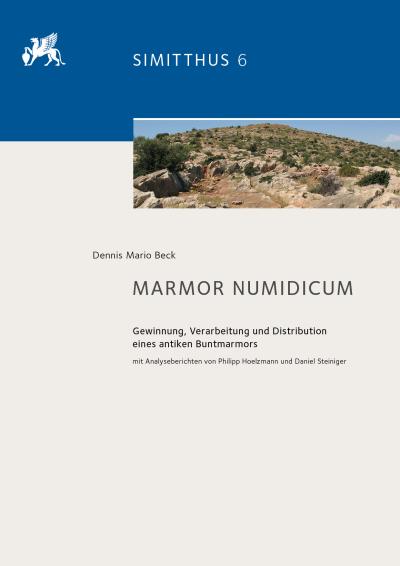Marmor Numidicum: Gewinnung, Verarbeitung und Distribution eines antiken Buntmarmors
https://doi.org/10.34780/3xe5-a0z6
Synopsis
Marmor Numidicum, also known as Giallo antico, is one of the best known and most widespread colored marbles of antiquity, and was quarried in Simitthus, today Chimtou in Tunisia. The present study is a holistic interdisciplinary approach to marmor Numidicum and combines the results from different research disciplines. The basis is a collection of archaeological material for the recording of the spectrum of use and the distribution of the marble in the Mediterranean area from the 2nd century B.C. to the 3rd century A.D. Based on this dataset, conclusions are drawn in a diachronic perspective both on the marble extraction and chronology in the quarries and on the urban genesis as well as the use and distribution range of the marble. The results are correlated by means of comparisons with administrative structures and questions of ownership, too. The study presents a periodization and localization of all variants of the marble to their extraction areas, considering archaeometric analyses of samples from the quarries for the first time in research. Another aspect concerns the role of marmor Numidicum within ancient trade systems. In order to get closer to these perspectives, questions about extraction, actors in trade networks, transport and logistic issues are comparatively analyzed with the help of the spectrum of use and distribution in diachronic evaluations and contextualized in case studies with the model of the chaîne opératoire. Theories and models from New Institutions Economics are discussed, too. Regarding the use of the local marble, the study yielded the result that the city of Simitthus and its quarries formed an entangled unit over the periods studied. Thus, for one of the most important colored marbles of antiquity a single study is now available.
Keywords:
marbles, colored marbles, ancient economy, ancient marble trade, ancient marble decorations, materiality, ancient quarriesChapters
-
Vorwort der Herausgeber
-
Vorwort des Autors
-
1 Einleitung
-
1.1 Zielsetzung und Fragestellungen
-
1.2 Forschungsstand zu antiken Buntmarmoren
-
1.4 Methodisches Vorgehen und theoretische Modelle der Arbeit
-
2 Die Marmorbrüche von Simitthus/Chimtou
-
2.1 Geographische Rahmenbedingungen
-
2.2 Modell der periodisierten Keilspalttechniken nach Josef Röder
-
2.3 Chronologische Anhaltspunkte in den Marmorbrüchen von Simitthus/Chimtou
-
2.4 Archäometrische Untersuchungen und Varianten des marmor Numidicum
-
3 Diachrone Materialaufnahme und Steinbruchgeschichte
-
3.1 Verwendung und Distribution des marmor Numidicum vom 2. Jh. – 27 v. Chr.
-
3.2 Verwendung und Distribution des marmor Numidicum von 27 v. Chr. – 96 n. Chr.
-
3.3 Verwendung und Distribution des marmor Numidicum von 96–161 n. Chr.
-
3.4 Verwendung und Distribution des marmor Numidicum von 161–235 n. Chr.
-
3.5 Marmor Numidicum nach dem Abzug der kaiserlichen Amtsträger
-
4 Zum Handel mit marmor Numidicum und den chaînes opératoires
-
4.1 Diachrone Perspektive: marmor Numidicum in der späten Republik
-
4.2 Chaîne opératoire: marmor Numidicum in der späten Republik
-
4.3 Diachrone Perspektive: Kaiser(zeit)‑licher Handel mit marmor Numidicum
-
4.4 Substituierung des marmor Numidicum
-
4.5 Marmorpreise
-
5 poikilia et varietas. Zur Wahrnehmung des marmor Numidicum in der Antike
-
6 Synthese
-
Zusammenfassung
-
Summary
-
Anhang
-
Anhang 1 Tabellarische Übersicht der Schriftquellen
-
Anhang 2 Übersicht der Architekturfragmente aus Giallo Antico vom Augustusforum
-
Anhang 3 Übersicht zu den Theatern
-
Anhang 4 Übersicht zur Kleinplastik
-
Anhang 5 Steinbruchinschriften und epigraphische Evidenz zu den Akteuren
-
Anhang 6 Übersicht zu den Marmorpreisen und Kalkulationen
-
Schaubilder zu den chaînes opératoires
-
CO1: Schaubild zur chaîne opératoire der späten Republik
-
CO2: Schaubild zur chaîne opératoire der frühen Kaiserzeit
-
CO3: Schaubild zur chaîne opératoire der hohen Kaiserzeit
-
Marmoranalysen
-
A: Die Marmorproben aus den Steinbrüchen von Simitthus/Chimtou
-
B: Bericht zur Analyse der Gesteinsproben
-
C: Marmorproben aus Chimtou und dem Archäologischen Zentrum Berlin
-
Abbildungsverzeichnis
-
Literaturverzeichnis
-
Distributions- und Übersichtskarten
-
Konkordanzliste der Befunde und Funde im iDAI.objects-Online Supplement
-
Register
-
Tafeln 1–18




